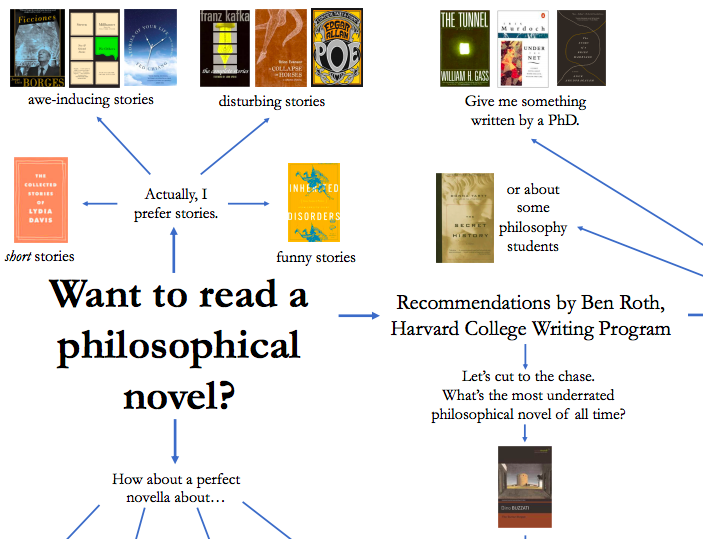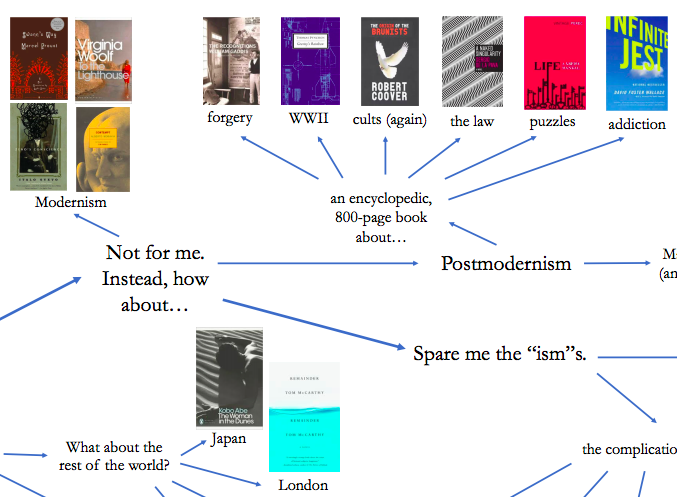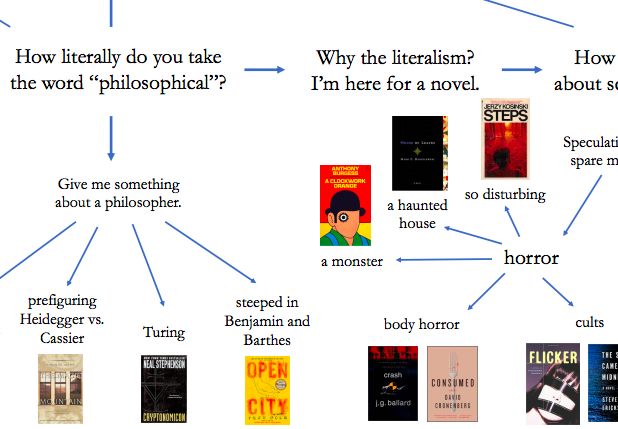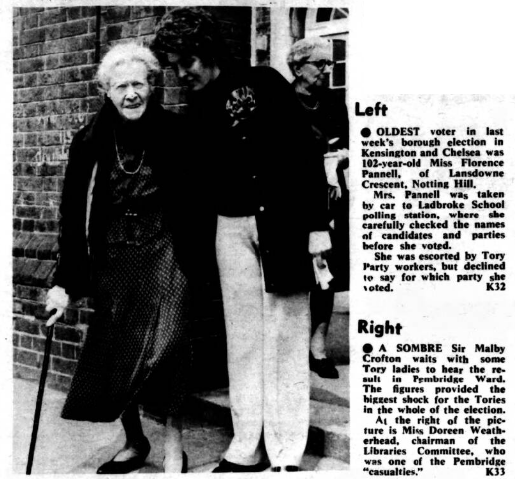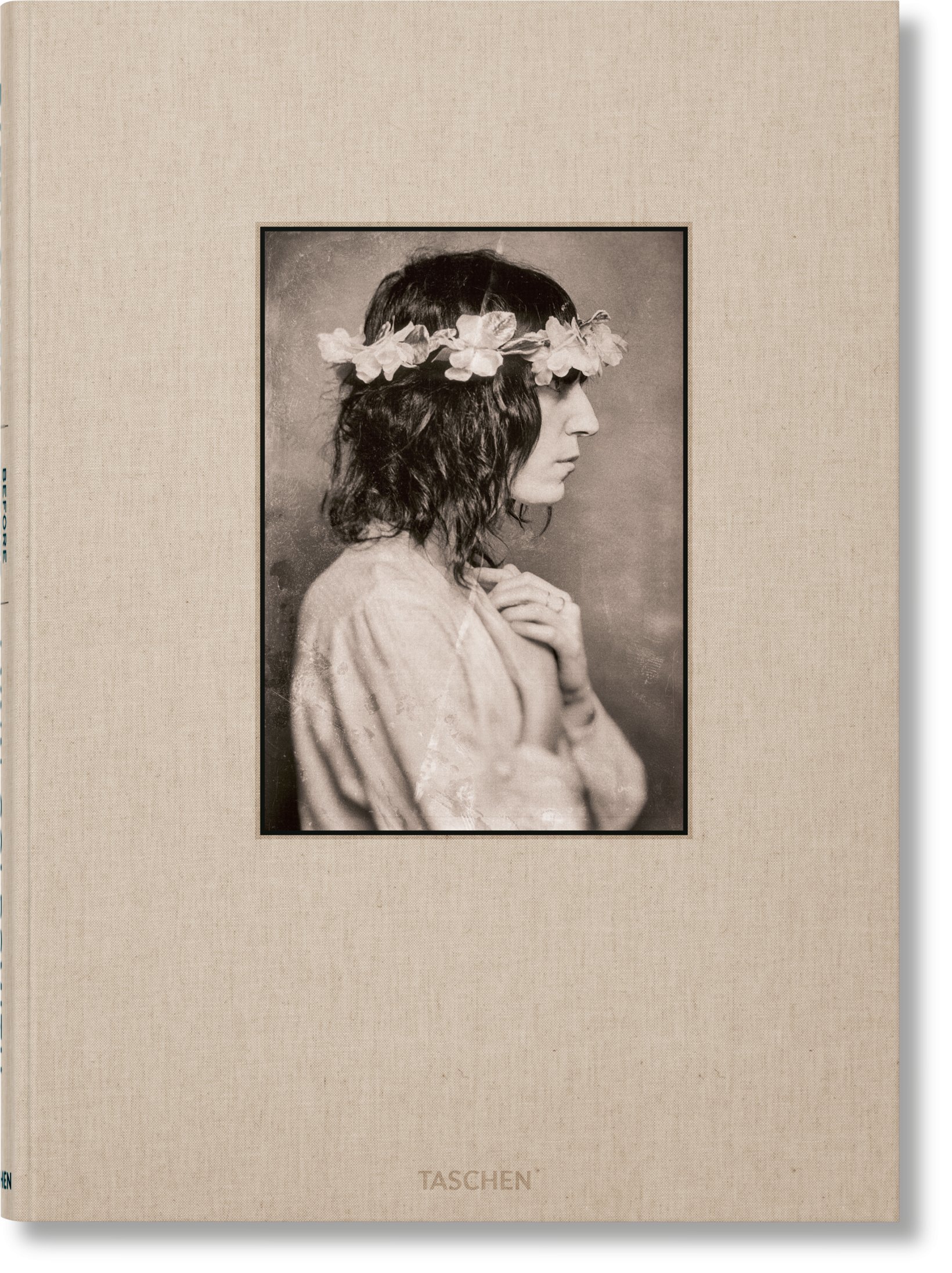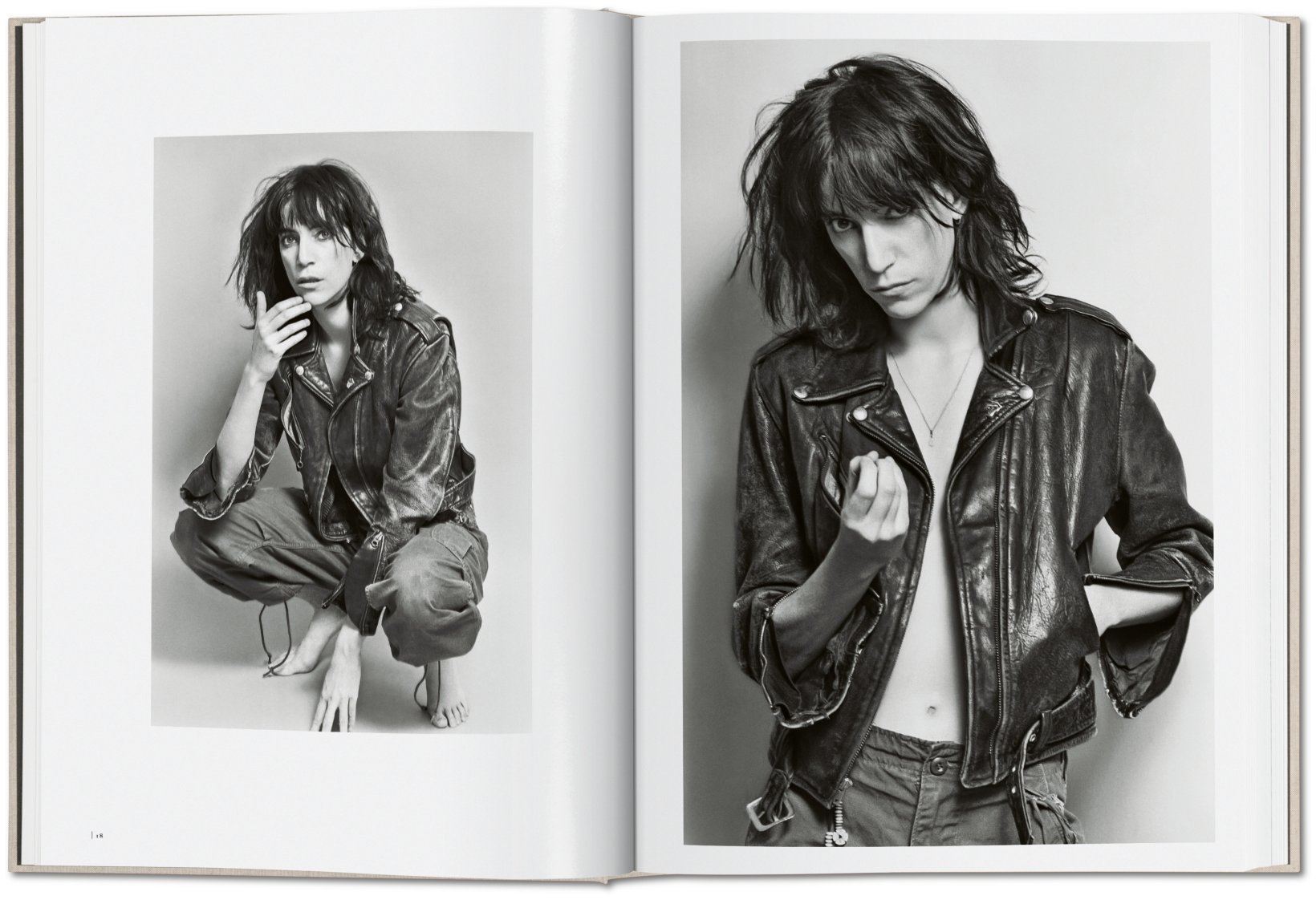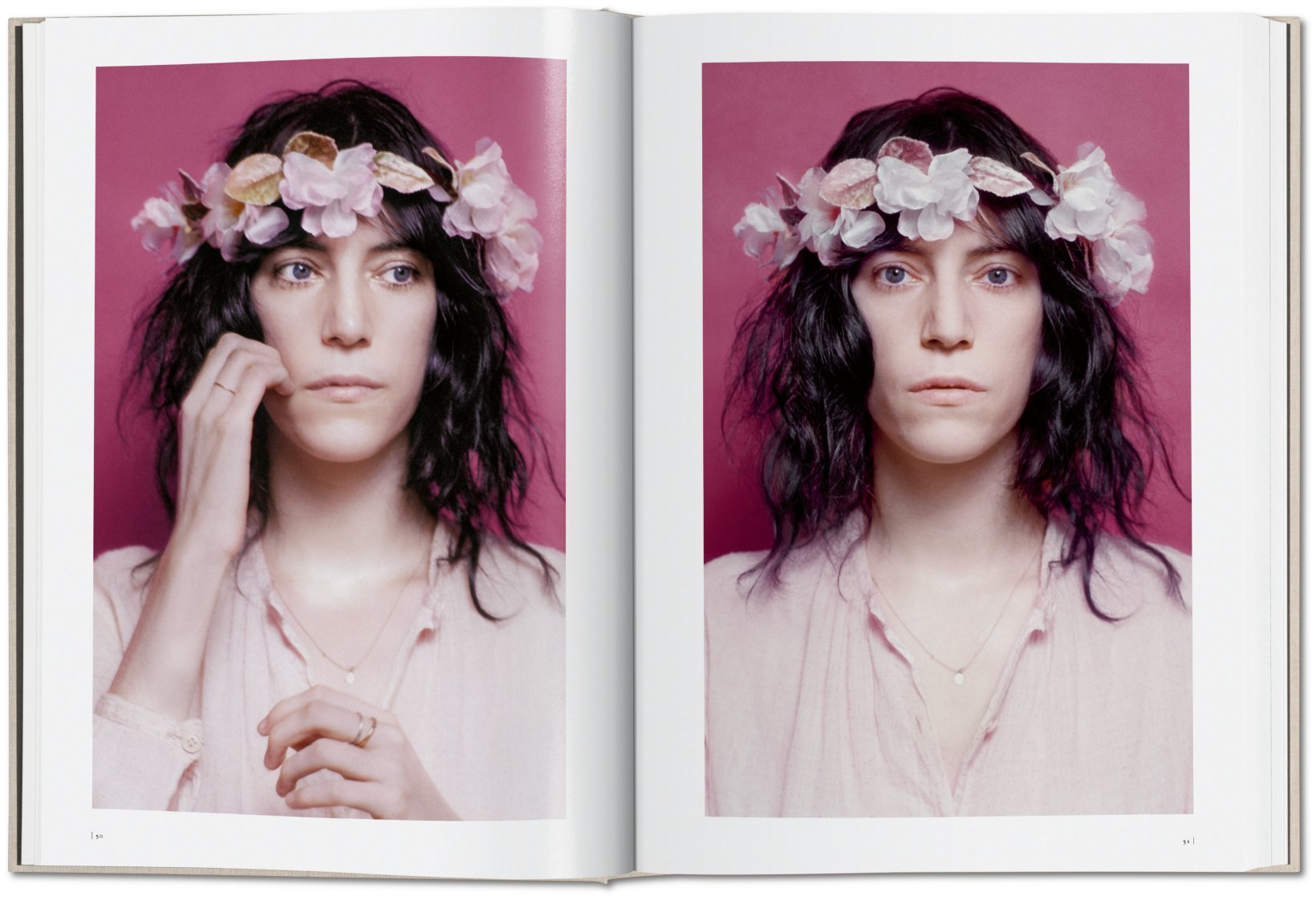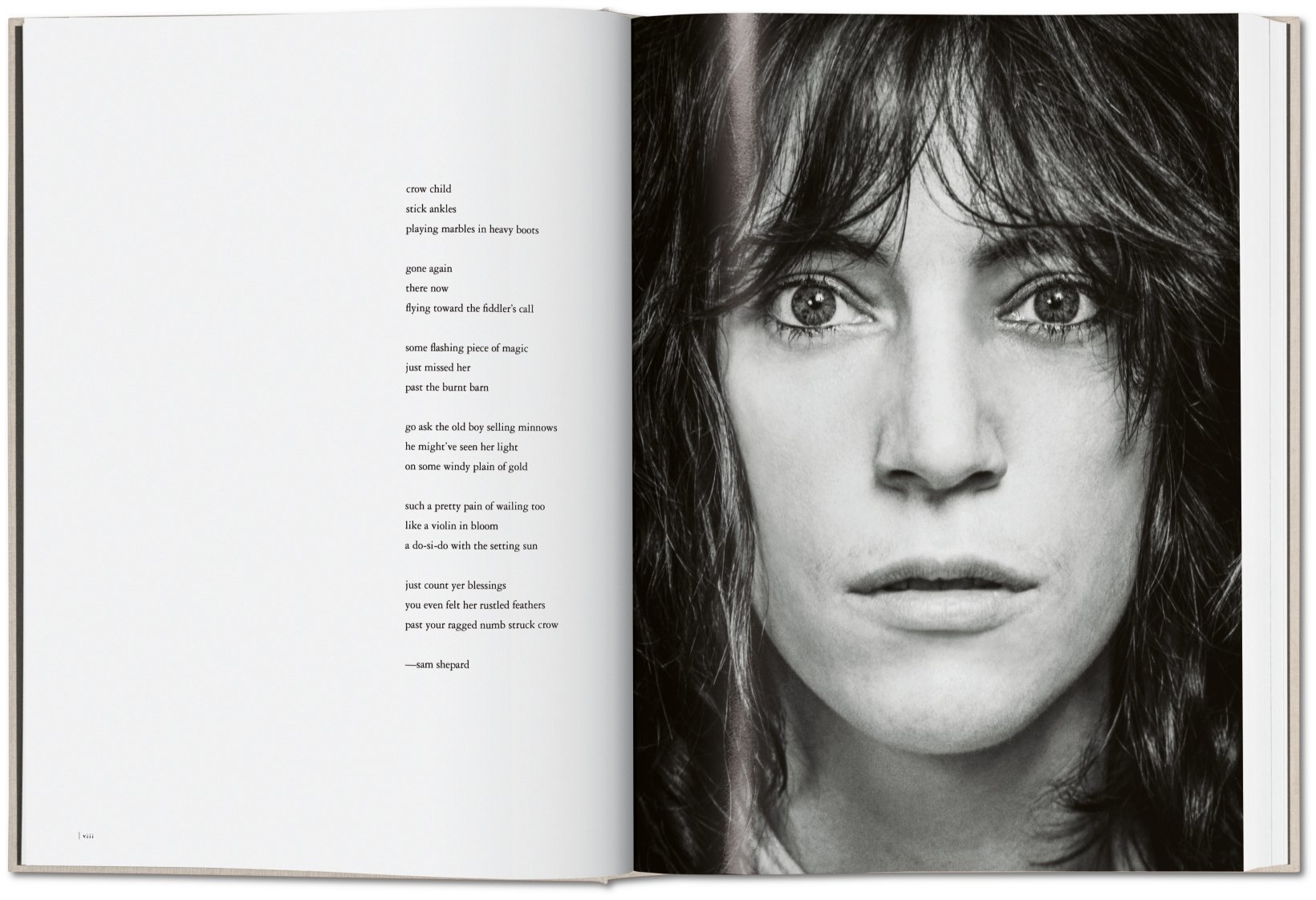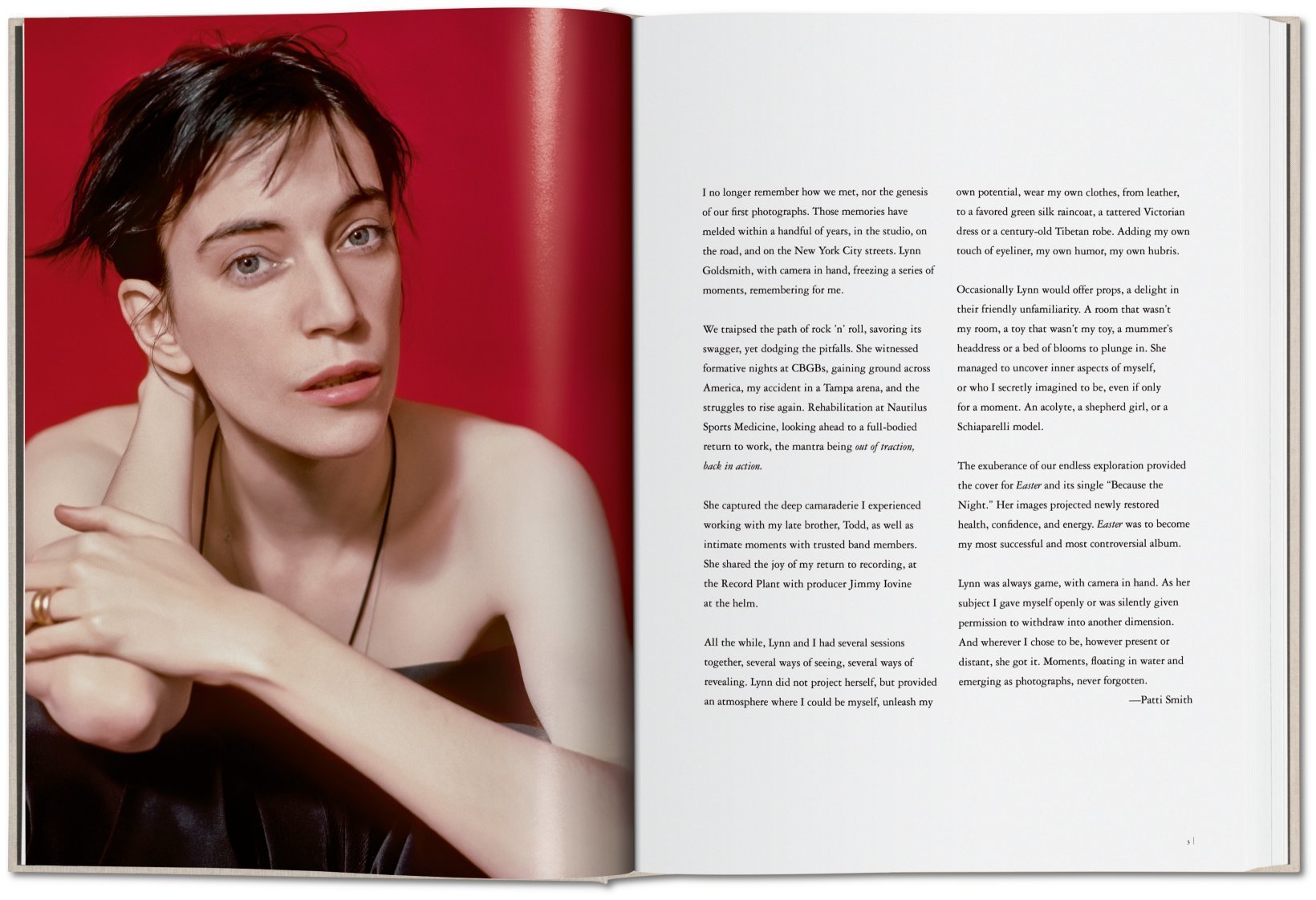[Most Recent Entries] [Calendar View]
Friday, October 25th, 2019
| Time | Event |
| 11:00a | A Flowchart of Philosophical Novels: Reading Recommendations from Haruki Murakami to Don DeLillo
Do you want to read a philosophical novel? Sure, we all do. But the question of exactly what kind of philosophical novel you want to read, let alone which individual book, isn't quite so easily answered. But now a professional has come to the rescue: "Ben Roth, a philosopher who teaches in the Harvard College Writing Program, has put together a kind of flowchart recommending philosophical novels and stories," reports Daily Nous' Justin Weinberg. "With categories like 'about a philosopher,' 'by a Ph.D.,' 'horror,' 'the complications of history,' and many more, the chart is pretty big." The choices you make in navigating it could land you on the work of a writer from one of a variety of countries, one of several eras, and one of a capacious range of definitions of "philosophical." If you take the word in the sense of a novel's being about or steeped in the work of a particular philosopher, Roth recommends books like Thomas Bernhard's Correction (Wittgenstein) and Teju Cole's Open City (Benjamin and Barthes). Elsewhere on the map he also includes novels written by philosophically credentialed academics like William Gass, Iris Murdoch, and Anuk Arudpragasam.
If you prefer novels where "fiction writers drop into straight essayistic mode," Roth offers a choice between the easy mode of Milan Kundera's The Unbearable Lightness of Being and the hard mode of Robert Musil's The Man Without Qualities. (If you just wanted to read about a bunch of philosophy students, well, there's always Donna Tartt's The Secret History.) To those who go in for more "novelly novels," as Geoff Dyer (a known Bernhard enthusiast and author of some pretty philosophical fiction himself) memorably put it, Roth presents more forks in the road: Would you like to read science fiction? Existentialism? Postmodernism? A book free of -isms entirely, or anyway as free as possible?
Your answers to those questions and others could have you reading anything from J.G. Ballard's Crash ("body horror") to Jean-Paul Sartre's Nausea ("mid-century French classic") to David Foster Wallace's Infinite Jest (postmodern, encyclopedic, on addiction). Other choices may lead you to selections less obviously involved with philosophy: J.M. Coetzee's Waiting for the Barbarians, or Virginia Woolf's To the Lighthouse, Haruki Murakami's Hard-Boiled Wonderland and the End of the World. Of course, you may not want to read a philosophical novel at all: you may want to read philosophical short stories, in which case Roth recommends such form-defining figures as Edgar Allan Poe, writer of "disturbing stories"; Lydia Davis, writer of "short stories" (emphasis his); and Jorge Luis Borges, writer of "awe-inducing stories."
Borges and quite a few other names on Roth's philosophical-novel flowchart also appear in critic David Auerbach's "Inquest on Left-Brained Literature," a revealing look at the authors read by "engineers with a literary bent." Both also include Don DeLillo, whose work Auerbach characterizes as making "heavy use of phantasmagoria, complemented by very sophisticated narrative construction," and "simple, visceral, classical themes approached in [a] flashy, novel way." Roth, for his part, describes DeLillo's White Noise as his "favorite book ever." Elsewhere on the flowchart, to the philosophical literature enthusiast who's read everything he offers "the most underrated philosophical novel of all time," Dino Buzzati's The Tartar Steppe. No, I haven't heard of it either, but I have to admit that it keeps good company. Related Content: Jorge Luis Borges Selects 74 Books for Your Personal Library R. Crumb Illustrates Jean-Paul Sartre’s Nausea: Existentialism Meets Underground Comics 44 Essential Movies for the Student of Philosophy Based in Seoul, Colin Marshall writes and broadcasts on cities, language, and culture. His projects include the book The Stateless City: a Walk through 21st-Century Los Angeles and the video series The City in Cinema. Follow him on Twitter at @colinmarshall or on Facebook. A Flowchart of Philosophical Novels: Reading Recommendations from Haruki Murakami to Don DeLillo is a post from: Open Culture. Follow us on Facebook, Twitter, and Google Plus, or get our Daily Email. And don't miss our big collections of Free Online Courses, Free Online Movies, Free eBooks, Free Audio Books, Free Foreign Language Lessons, and MOOCs. |
| 2:30p | A 108-Year-Old Woman Recalls What It Was Like to Be a Woman in Victorian England The perils of old age—dementia, economic insecurity, social isolation—are receiving a lot of attention these days. How refreshing to spend three minutes in the company of a sharp-witted 108-year-old, who, responding to a question about what life was like for women in Victorian England, acts out a couple of socially relevant, period Punch cartoons, deliberately drawing attention to her shockingly well-preserved ankles in the process. Florence Pannell was born in London in 1868, 3 years after the US abolished slavery and eleven before the advent of the electric lightbulb. Her appearance on Thames Television’s Money-Go-Round program appears to be her only public recording. The Kensington Post captured her leaving her polling place, after casting her ballot in a 1971 election at the age of 102.
It’s a pity there’s not more of an online presence, as this captivating storyteller clearly relishes the opportunity to revisit the past. A pity too, that she was stuck with a dud of an interviewer, Joan Shenton, who has gone on to find fame as a prominent AIDS denialist. The AIDS crisis is one event of global historical importance that Mrs. Pannell missed—barely—she died in 1980, a few months shy of her 112th birthday. We learn that she founded a successful beauty care business that took her to Paris for a time, but other than that, the details of her private life are left to our speculation. She was married. Did she have children, and if so, did she survive them? Did she ever get the chance to go up in an airplane? As of 1977, she hadn’t, but was open to the idea, implying that the risk had outweighed the potential thrill in the early days of aviation. Most striking is her hearty reply concerning the biggest change she had witnessed over the years: Everything! Nothing is the same! Everything’s changed! Some of the milestones she was alive for, as noted by various YouTube and Reddit commenters: The coronation of the five monarchs to follow Queen Victoria: Edward VII, George V, Edward VIII, George VI and Elizabeth II (whose 93 years on the planet she makes seem marginally less impressive) Jack the Ripper’s terrorization of London The sinking of the Titanic Both World Wars The Great Depression The telephone Television The hippie movement The moon landing Another commenter suggested that it would have been mathematically possible for Mrs. Pannell to have heard stories about Napoleon at her grandpa’s knee. Readers, what are you boggled by, with regard to the significant events transpiring within this woman’s lifetime? (And for those curious as to her formidable accent, there’s a wealth of linguistic information here.) Related Content: Ayun Halliday is an author, illustrator, theater maker and Chief Primatologist of the East Village Inky zine. Join her in NYC on Monday, November 4 when her monthly book-based variety show, Necromancers of the Public Domain celebrates Louise Jordan Miln’s “Wooings and Weddings in Many Climes (1900). Follow her @AyunHalliday. A 108-Year-Old Woman Recalls What It Was Like to Be a Woman in Victorian England is a post from: Open Culture. Follow us on Facebook, Twitter, and Google Plus, or get our Daily Email. And don't miss our big collections of Free Online Courses, Free Online Movies, Free eBooks, Free Audio Books, Free Foreign Language Lessons, and MOOCs. |
| 4:14p | Beautiful New Photo Book Documents Patti Smith’s Breakthrough Years in Music: Features Hundreds of Unseen Photographs
Patti Smith is always surprising her fans with new work and new opportunities to admire her commitment to art and activism. If she isn’t publishing another memoir, or leading 250 people in a protest song, she’s showing her photographs, which she’s taken since the 60s, with Polaroid cameras and a German Minox 35EL. “I am not a photographer,” she says, “yet taking pictures has given me a sense of unity and personal satisfaction. They are relics of my life. Souvenirs of my wandering.” She surprised her fans once again by putting her treasury of pictures on Instagram. But as comfortable as Smith has been behind the camera, she has been even more relaxed in front of it: “widely regarded as a style icon,” writes Stephanie Eckardt at W magazine, “she’s been a magnet for photographers almost immediately” after she arrived in New York “to hang around CBGB's and pose for Robert Mapplethorpe.” She appeared in plenty of photos with Mapplethorpe when the two were just kids. Photographer Frank Stefanko captured her bohemian lounging in the 60s and 70s in stark black and white. (When he first encountered her in South Jersey, he says, she looked like “the bad guy walking into a saloon in an old Western movie.”)
“There are many photographers who have photographed Patti who are wonderful artists,” writes Lynn Goldsmith, whose own striking photographic record of Smith’s career is now being published in a new book by Taschen titled Before Easter After. (The book will be released in November.) Unlike Goldsmith, however, “they did not do documentary as well as concert as well as studio work with her. So that enabled Patti and I to have a narrative in the book that we could share with people of what was going on at that time.”
Smith describes what was going on with her usual casual lyricism:
She refers to her fall offstage in 1977 while the band toured their album Radio Ethiopia. She broke her neck and spent the year recovering. Goldsmith captured the tragic event: “I saw her nearing the edge of the stage, but I thought she knew what she was doing because she always did this turning dervish on that song, where she spun and spun and spun.” The following year, the band released Easter, their third and “most widely known and distributed” album, notes AnOther, and Goldsmith nervously shot Smith onstage at CBGBs in a neck brace.
The photographer surprised Smith by asking her longtime friend Sam Shepard to write a poem for the book inspired by the 1977 photo above. And at the book’s October 8th launch party, which included Henry Rollins, Rosanna Arquette, Moon Zappa, and John Densmore, Smith surprised her 150 guests by playing a set of songs “inspired by Goldsmith’s previous unseen photographs of the transformative period documented in the book,” writes Taschen. “She ended her set with her best-known hit ‘Because the Night’ from the album Easter… joined in song by every person in the room.”
The book is available in a pricey edition from Taschen (you can pre-order it here) and, coming soon, even pricier, numbered Art Editions. Here’s hoping they’ll surprise Patti Smith fans for the holidays with a paperback. Related Content: Patti Smith, The Godmother of Punk, Is Now Putting Her Pictures on Instagram Patti Smith Sings “People Have the Power” with a Choir of 250 Fellow Singers Patti Smith’s 40 Favorite Books Josh Jones is a writer and musician based in Durham, NC. Follow him at @jdmagness Beautiful New Photo Book Documents Patti Smith’s Breakthrough Years in Music: Features Hundreds of Unseen Photographs is a post from: Open Culture. Follow us on Facebook, Twitter, and Google Plus, or get our Daily Email. And don't miss our big collections of Free Online Courses, Free Online Movies, Free eBooks, Free Audio Books, Free Foreign Language Lessons, and MOOCs. |
| << Previous Day |
2019/10/25 [Calendar] |
Next Day >> |
